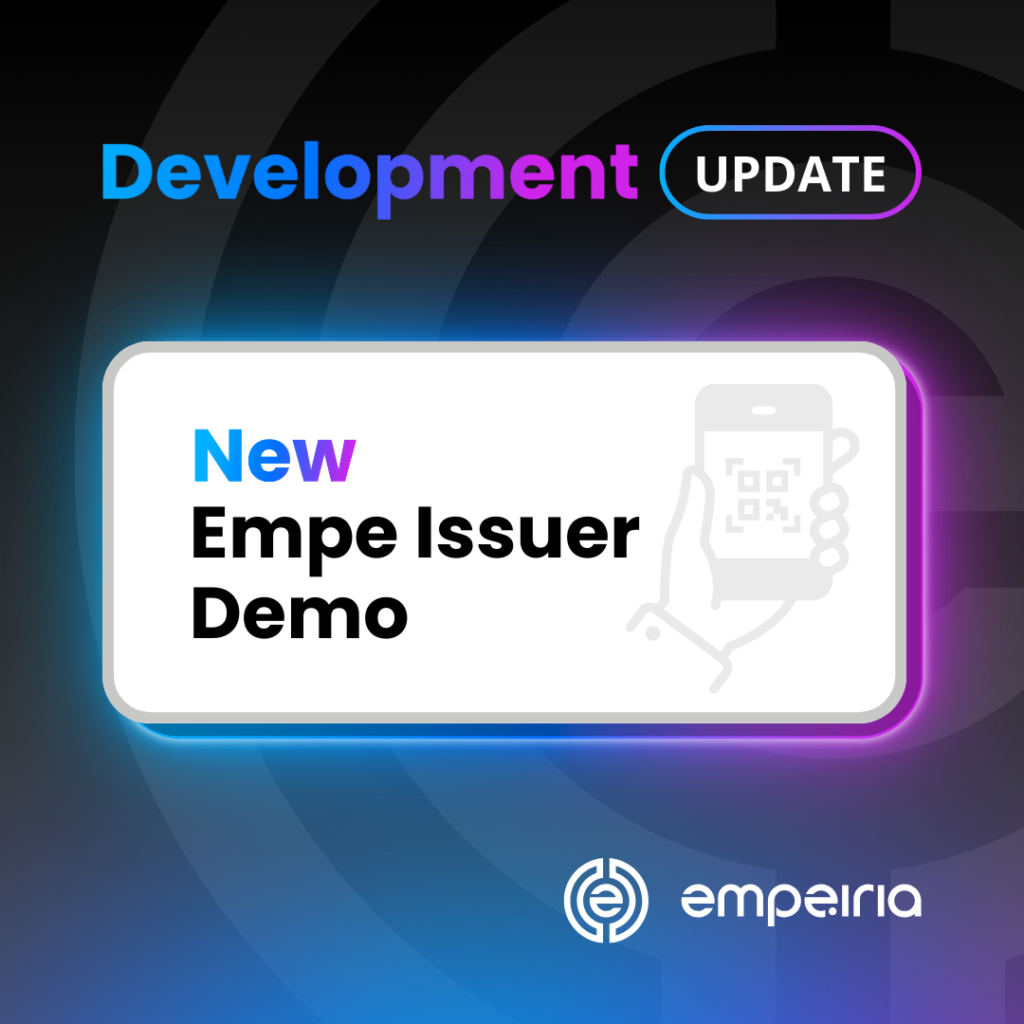User experience and real-world utility are at the core of our mission. This is why, in this latest development update, we focus on making system integration smoother and more flexible than ever, and demonstrate real-world use cases through our latest Empe Issuer Demo.
This update highlights both the technical enhancements in our architecture and practical implementations of our solutions. Whether you’re a technical expert or new to the field, you’ll gain insights into how our tools can benefit your own projects and be applied in your everyday life.
Technical Architecture Update
Overview
Our restructured architecture emphasizes modularity and ease of deployment, making integration with client systems as seamless as possible. We’ve split the system into distinct, independent microservices that handle key roles, like verification and issuance. This approach allows us to provide a plug-and-play experience, ensuring minimal disruption for clients who want to adopt our system.

Key Components and Services Breakdown
1. Issuer Service (IS)
The Issuer Service is a self-contained component responsible for managing verifiable credentials’ issuance. It’s designed to be easy to deploy independently and interact directly with the user’s wallet for issuing verifiable credentials. This isolation allows clients to integrate verifiable credentials’ issuance capabilities without overhauling their existing systems.
2. Verifier Service (VS)
Similarly, the Verifier Service is an independent, deployable service focused solely on verifiable credential verification. When a verification request is initiated, the Verifier Service communicates with the Wallet for Verifiable Presentation (VP) requests and resolves DIDs through the Empeiria Blockchain. By isolating verification functions into a standalone service, clients can easily plug our verification component into their environments.
3. Client-Server (User’s Own System)
A unique aspect of our architecture is that the Client-Server and Application Logic are assumed to be part of the client’s own system. This means that users deploying our solution will manage their own Client-Server and Application Logic, which can interact with our Verifier and Issuer Services as required. We provide a client-side component that facilitates communication with the Verifier Service, making integration straightforward and minimally invasive. Our goal here is to offer a component that can be easily incorporated into the client’s infrastructure, connecting their environment with our verification and issuance services in a plug-and-play manner.
4. Empe Blockchain (DID Document Repository)
The Empe Blockchain serves as a decentralized repository for DID documents, supporting trustless DID resolution for verifiable credential verification. This integration aligns with our commitment to Self-Sovereign Identity (SSI) principles, allowing client systems to verify DIDs without relying on a centralized authority.
Why does this matter?
These improvements simplify the integration process, enabling faster adoption and smoother transitions for clients. By breaking down our system into modular microservices, we make it easier for organizations to adopt and scale without major disruptions to their existing workflows.
• Modularity and Plug-and-Play: By providing the Verifier and Issuer as standalone services, we enable clients to deploy only what they need, keeping integration simple and scalable.
• Minimal Invasiveness: Since the Client-Server and Application Logic are entirely managed by the user, our solution integrates with a client’s existing infrastructure seamlessly. Our components are designed to be added as independent plugins, enhancing the client’s system without disrupting it.
• Security and Flexibility: By isolating the verification and issuance processes, we enhance security and provide flexible deployment options. Each service operates independently, ensuring clients can scale and update components as needed.

New Empe Issuer Demo
Overview
To illustrate how our architecture supports real-world use cases, we’ve created a demo that shows various use cases our system can support. This demo helps potential clients envision practical ways to leverage our services in verifiable credential-based workflows, providing value in fields like identity management, event access, secure data sharing, and more.
The new Empe Issuer Demo complements the Empe DID Wallet. Powered by Empe Blockchain, it is a fast and secure way to experience the practical benefits of our solutions in real-life scenarios.
Download the Empe DID Wallet from the Apple App Store and Google Play Store and use it on the Empe Issuer website to explore the following use cases.
Use Cases
1. Passwordless Login with Empe DID Wallet
Users can log in to an example web service by simply proving ownership of their Decentralized Identifier (DID) through the Empe DID Wallet. This feature is an easy add-on for clients who want to replace traditional passwords with secure, passwordless authentication, simplifying the user experience.
2. Proof of Purchase Verifiable Credential
In this example, the Issuer Service issues a “proof of purchase” verifiable credential, such as a ticket for an event, directly to the user’s Wallet. This shows how our solution can streamline ticketing and proof-based verifiable credential issuance, enabling organizations to manage access more efficiently.
3. Conditional Verifiable Credential Flow (Proof of Attendance)
This flow requires a “proof of purchase” verifiable credential to be presented before issuing a “proof of attendance” verifiable credential. The conditional logic illustrates how our system can enable progressive access control, where one credential serves as a prerequisite for another, allowing clients to create step-by-step verification processes.
4. Birth Certificate Form Verifiable Credential
Here, we demonstrate a more complex form-based verifiable credential issuance, suitable for official documents like birth certificates. By completing a detailed form, users can receive a birth certificate credential, showing how our system handles structured data securely. This use case is particularly relevant for government and healthcare organizations where such credentials are needed.
5. Data Sharing Flow
This flow demonstrates how verifiable credential data can be shared with trusted entities by a user. In this scenario the user is requested to provide certain data (Birth Certificate Verifiable Credential), and upon confirming in their wallet app, it’s securely transferred to a requestor (verifier) service. This functionality is valuable in scenarios where credential data needs to be shared safely between systems.
Why does this matter?
The new Empe Issuer Demo highlights the utility and flexibility of our solution. From secure logins to proof of purchase, conditional access, and complex verifiable credential management, our system adapts to diverse needs.
By prioritizing modular services and seamless integration, we empower clients across industries to implement our End-to-End Verifiable Data Infrastructure (EVDI) for a variety of applications, while the new Empe Issuer Demo showcases real-life utility of our solutions.
These updates represent a significant step toward a more efficient, secure, and user-friendly verifiable data ecosystem. Your continued support and feedback remain vital, and we deeply value your involvement as we advance together.
Follow Empeiria on X, or LinkedIn for the latest news & updates. For inquiries or further information, contact Empeiria at [email protected]














